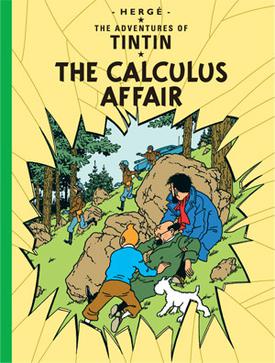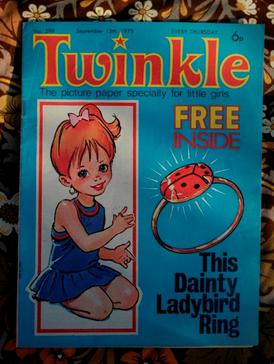
The Adventures of Tintin is a series of 24 comic albums created by Belgian cartoonist Georges Remi, who wrote under the pen name Hergé. The series was one of the most popular European comics of the 20th century. By 2007, a century after Hergé's birth in 1907, Tintin had been published in more than 70 languages with sales of more than 200 million copies, and had been adapted for radio, television, theatre, and film.

Prince Valiant in the Days of King Arthur, often simply called Prince Valiant, is an American comic strip created by Hal Foster in 1937. It is an epic adventure that has told a continuous story during its entire history, and the full stretch of that story now totals more than 4000 Sunday strips. The strip appears weekly in more than 300 American newspapers, according to its distributor, King Features Syndicate.
Disney comics are comic books and comic strips featuring characters created by the Walt Disney Company, including Mickey Mouse, Donald Duck and Scrooge McDuck.

Ligne claire is a style of drawing created and pioneered by Hergé, the Belgian cartoonist and creator of The Adventures of Tintin. It uses clear strong lines sometimes of varied width and no hatching, while contrast is downplayed as well. Cast shadows are often illuminated, and the style often features strong colours and a combination of cartoonish characters against a realistic background. The name was coined by Joost Swarte in 1977.
Methuen Publishing Ltd is an English publishing house. It was founded in 1889 by Sir Algernon Methuen (1856–1924) and began publishing in London in 1892. Initially Methuen mainly published non-fiction academic works, eventually diversifying to encourage female authors and later translated works. E. V. Lucas headed the firm from 1924 to 1938.

Tintin in the Congo is the second volume of The Adventures of Tintin, the comics series by Belgian comic strip artist Hergé. Commissioned by the conservative Belgian newspaper Le Vingtième Siècle for its children's supplement Le Petit Vingtième, it was serialised weekly from May 1930 to June 1931 before being published in a collected volume by Éditions de Petit Vingtième in 1931. The story tells of young Belgian reporter Tintin and his dog Snowy, who are sent to the Belgian Congo to report on events in the country. Amid various encounters with the native Congolese people and wild animals, Tintin unearths a criminal diamond smuggling operation run by the American gangster Al Capone.

The Calculus Affair is the eighteenth volume of The Adventures of Tintin, the comics series by the Belgian cartoonist Hergé. It was serialised weekly in Belgium's Tintin magazine from December 1954 to February 1956 before being published in a single volume by Casterman in 1956. The story follows the attempts of the young reporter Tintin, his dog Snowy, and his friend Captain Haddock to rescue their friend Professor Calculus, who has developed a machine capable of destroying objects with sound waves, from kidnapping attempts by the competing European countries of Borduria and Syldavia.

Edgard Félix Pierre Jacobs, better known under his pen name Edgar P. Jacobs, was a Belgian comic book creator, born in Brussels, Belgium. He was one of the founding fathers of the Franco-Belgian comics movement, through his collaborations with Hergé and the graphic novel series that made him famous, Blake and Mortimer.

Dylan Horrocks is a New Zealand cartoonist best known for his graphic novel Hicksville and his scripts for the Batgirl comic book series.
British small press comics, once known as stripzines, are comic books self-published by amateur cartoonists and comic book creators, usually in short print runs, in the UK. They're comparable to similar movements internationally, such as American minicomics and Japanese doujinshi. A "small press comic" is essentially a zine composed predominantly of comic strips. The term emerged in the early 1980s to distinguish them from zines about comics. Notable artists who have had their start in British small press comics include Eddie Campbell, Paul Grist, Rian Hughes, Jamie Hewlett, Alan Martin, Philip Bond and Andi Watson.
Stan Woch is an American comics artist who has worked on comic strips and comic books.
The Max und Moritz Award , also known as the Max & Moritz Prize , is a prize for comic books, comic strips, and other similar materials. It has been awarded at each of the biennial International Comics Shows of Erlangen since 1984, and is awarded in several categories, including an audience award and lifetime achievement award. It is open to all material published in Germany.

91:an is a popular bi-weekly Swedish comic book published by Egmont Kärnan AB. First brought out in 1956, it primarily publishes comic strips by Swedish cartoonists.

Garen Ewing is an illustrator, designer and most notably a comic creator, being the writer and illustrator of The Adventures of Julius Chancer - The Rainbow Orchid.

Twinkle, "the picture paper specially for little girls," was a popular British comics magazine, published by D. C. Thomson & Co. Ltd from 27 January 1968 to 1999. It was aimed at young girls and came out weekly, supplemented each year with a Summer Special and a hardcover Annual.

The DFC was a weekly British children's anthology comic, published by David Fickling Books. The first issue was published at the end of May 2008. The title stood for "David Fickling Comic". Its successor, The Phoenix, launched on 7 January 2012.
Notable events of 1967 in comics.

Sydney Leon Miller was a prolific Australian artist celebrated for his black-and-white work as a cartoonist, illustrator, caricaturist and comic-book author. Known professionally as Syd Miller, he was employed as a staff-artist for Smith's Weekly from late-1922 until 1935, when he left to pursue a diversity of freelance work. Miller created a number of comic-strips during his career, most notably the iconic 'Chesty Bond' character as a marketing campaign for the Australian clothing company Bonds. He also wrote and illustrated the Rod Craig comic-strip which was serialised from 1946 to 1955 and syndicated across Australia and internationally.

The British Comic Awards (BCA) were a set of British awards for achievement in comic books. Winners were selected by a judging committee; the awards were given out on an annual basis from 2012 to 2016 for comics made by United Kingdom creators published from September of the previous year until September of the current year. Award presentations were held at the Leeds Thought Bubble Festival, in the fall of the year.

"The Astounding Adventures of Charlie Peace" is a British comic strip published in the weekly anthology Buster from 27 June 1964 to 15 June 1971, published by Fleetway Publications and later IPC Magazines. It was previewed by a single instalment in Valiant on 20 June 1964. The strip featured fictionalised adventures of the real-life Victorian era criminal Charles Peace.














